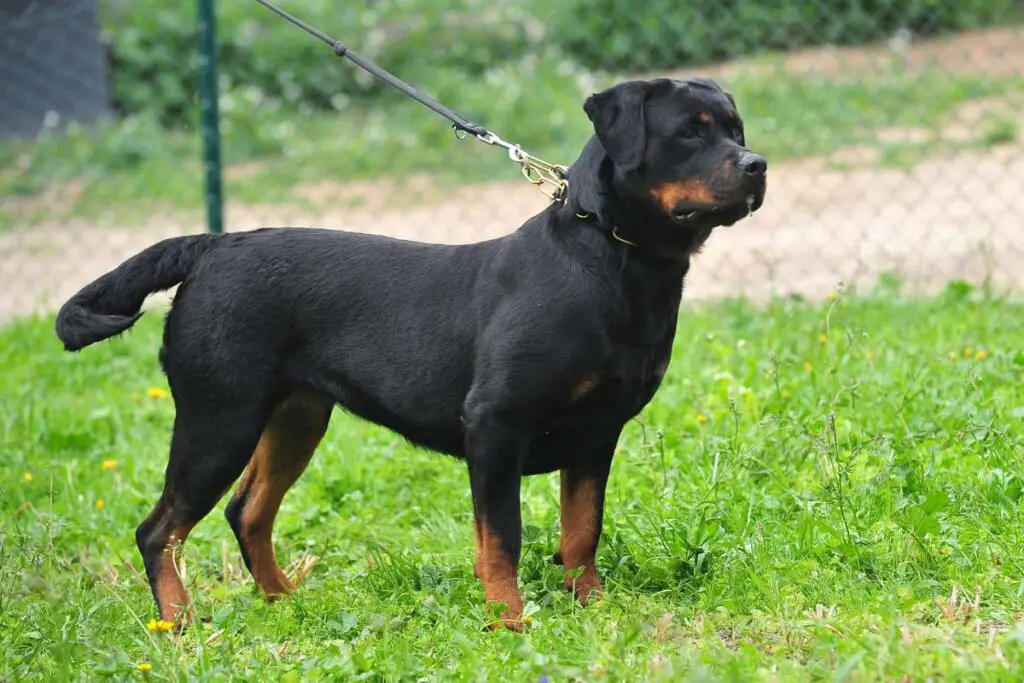Ever looked at a Rottweiler and thought, “Hmmm, I wonder if it’s a mix?” Don’t worry; I’ve got your back! Here are seven things to check for that can help you find out whether your Rottie is a purebred or a mix.
1. Look at their size.

Rottweilers are known for being large and powerful dogs. An adult male usually weighs between 95 to 135 pounds and stands about 24 to 27 inches high at the shoulder.
Females are a bit smaller, generally weighing between 80 to 100 pounds and standing about 22 to 25 inches high at the shoulder.
Remember, these measurements are for healthy, fully-grown dogs, so if your pup is still young, they might not be there yet. But if your full-grown Rottweiler is way off these ranges, there might be another breed in their family tree.
For instance, if your dog is a lot smaller, they might be mixed with a smaller breed. On the other hand, if they’re much larger, they might have a giant breed in their background.
2. Check out their color and markings.

Purebred Rottweilers have a specific color and pattern that’s pretty easy to recognize once you know what to look for. They’re always black with well-defined tan or rust-colored markings in particular spots. You should see these markings above their eyes, on their cheeks, on the sides of the muzzle, on their chest and legs, and beneath their tail. Here are some common rottweilers colors and markings.
If your dog has these colors and markings, there’s a good chance they’re a purebred Rottweiler. But if they’re any other color, or if their markings are different or in the wrong places, it could mean they’re a mix. Here are a few dog breeds that looks like rottweilers but aren’t.
For example, if your dog is all black, all tan, or has spots or patches, they might have some other breed in their background.
3. Study their head and muzzle shape.

The head of a Rottweiler is one of its most distinctive features. It should be medium length and broad between the ears. The forehead is rounded, but it’s also reasonably flat, and it should have a noticeable stop (that’s the spot where the nose and forehead meet).
The muzzle is straight and strong, and it’s about the same length as the skull, giving the head an overall balanced look. If your dog’s head is long and narrow, or if the muzzle is short and upturned (like a Bulldog’s), or elongated (like a Collie’s), it could mean there’s a different breed in their genes. Also, Rottweilers should have tight, neat lips, not droopy ones.
So if your pup has jowls like a Saint Bernard, they might be a mix.
4. Look at their tail.

Rottweilers have a tail that is in line with the top of their back when relaxed but may raise a bit when they are excited or active.
Purebred Rotties are born with a full tail, but it is often docked (or shortened) when they are very young. This practice started back when Rottweilers were used for herding and the tail was docked to prevent injury.
However, in many places, this practice is no longer allowed, so a purebred Rottie might still have its full tail.
If your Rottweiler’s tail is curly like a Pug’s or really fluffy like a Husky’s, there’s a chance they might be mixed with another breed.
5. Check their coat.

Rottweilers have a coat that is straight, dense, and of medium length. It’s made of a topcoat and an undercoat. The topcoat is coarse and flat, while the undercoat, which they usually have on their neck and thighs, is a bit softer and not as dense.
This coat helps protect them in both hot and cold weather. If your Rottie’s coat is long, curly, very short, or has a different texture, they might be a mix.
For example, if your dog’s coat is curly like a Poodle’s or long and silky like a Golden Retriever’s, then they might not be a purebred Rottweiler.
6. Pay attention to their behavior.

This point is a bit tricky because every dog is unique and has its own personality. But generally speaking, Rottweilers are known to be calm, confident, and courageous.
They tend to be very loyal and protective of their family, which makes them excellent guard dogs. They’re often reserved with strangers but not hostile unless they feel their family is threatened.
If your Rottie is excessively timid, overly aggressive, or displays behaviors more associated with other breeds, they might be mixed. However, remember, training and socialization play a huge part in a dog’s behavior, so this isn’t a foolproof sign.
7. Get a DNA test.

If you’re still unsure after all these checks, you can get a doggy DNA test. This test is a simple way to know for sure what breeds make up your furry friend. It usually involves a cheek swab or blood sample that you send off to a lab.
After a few weeks, you’ll get a report showing the different breeds in your dog’s background. This is the most reliable method to confirm if your Rottweiler is a purebred or mixed. It’s kind of like those ancestry tests for people!
Final Thoughts
Remember, whether your Rottie is a purebred or a mixed breed, they’re still an awesome pup who deserves all your love. But it’s always cool to know more about your furry friend, right?





